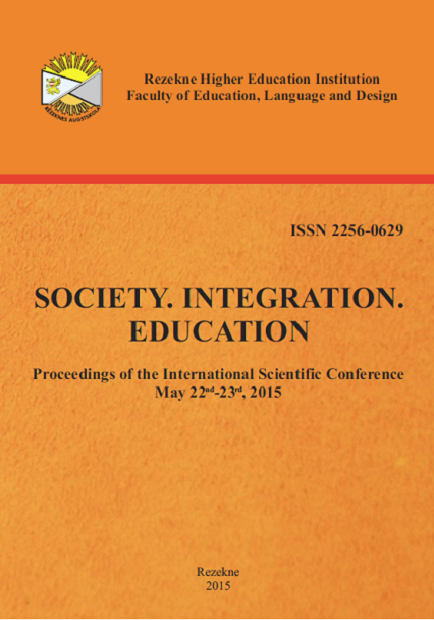Latent Structure of Reflective Learning at the Higher Educational Institution: Mixed Methods Research Results
DOI:
https://doi.org/10.17770/sie2015vol1.307Keywords:
reflective learning, higher education, mixed methods researchAbstract
The article presents results of the research, conducted using mixed methods research strategy: the reflective learning model as a prerequisite for curriculum development and improvement in university studies. The qualitative study was implemented using unstructured reflections, written by 65 prospective special educators studying at the university. The phenomenological hermeneutical method of data analysis enabled to disclose students’ experiences as preconditions for reflective learning, continuing studies at the university, and reveal impact on changes in personal conceptions, based on reflection of experienced situations. The quantitative study, which was attended by 389 students, aimed to disclose general trends of students’ reflective learning in theoretical and practical studies. Primary and secondary factor analyses enabled to disclose the latent structure of the investigated phenomenon – reflective learning. The constructed reflective learning model, based on prospective special educators’ example, can be described by 7 key dimensions, which can be treated as main trends, seeking improvement of the curriculum, implementing reflective learning at the higher education institution, and development of students’ reflection competency during studies.
References
Black, S. (2005). Teaching students to think critically. The Education Digest, 70(6), 42–47.
Boud, D., Keogh, R., Walker, D. (2005). Reflection: Turning Experience into Learning. London and New York: RoutledgeFalmer.
Bubnys R. & Tuominienė J. (2008). Studentų asmeninio augimo prielaidos taikant reflektyvaus dienoraščio / žurnalo metodą studijų procese. Ugdymo psichologija, 19, 59–67.
Bubnys, R. (2007). Mokymosi lygių įvairovė kaip reflektyvaus ugdymo aukštojoje mokykloje prielaida. Ugdymo psichologija, 18, 61–68.
Bubnys, R. (2010). Veiklos reflektavimo ir mokymosi teorinėse studijose iniversitete integralumas. Pedagogika, 99, 38–44.
Bubnys, R. (2011). Reflective Learning in the Training of Prospective Specialists at a Higher Education Institution. In. Beyond Fragmentation: Didactics, Learning and Teaching in Europe / Brian Hudson, Meinert A. Meyer (eds.) 2011, p. 139-153. Opladen & Farmington Hills: Barbara Budrich Publishers.
Bubnys, R. (2012). Reflektyvaus mokymo(si) metodų diegimo aukštojoje mokykloje metodika: refleksija kaip besimokančiųjų asmeninės ir profesinės raidos didaktinis metodas. Šiauliai: Šiaulių kolegijos leidybos centras.
Bubnys, R. & Gudonis, V. (2009). Prospective Special Educators’ Reflection on Personal Experience and its Integration in Practical Studies in Higher School. Special Education, 2 (21), 91–98.
Bubnys, R. & Žydžiūnaitė, V. (2007). Experiences of Prospective Special Pedagogues in Practical Studies at a Higher School: Results of the Analysis of Written Reflections. Specialusis ugdymas, 2 (17), 40-50.
Bubnys, R. & Žydžiūnaitė, V. (2008). Reflektuojančio būsimo specialiojo pedagogo profesinio apsisprendimo patirtys. Mokytojų ugdymas, 12 (2), 80–94.
Bubnys, R., Žydžiūnaitė, V. (2010). Reflective Learning Models in the Context of Higher Education: Concept Analysis. Problems of Education in the 21st Century (Issues in Educational Research-2010), 20, 58-70.
Choy, S. C. & Cheah, P. K. (2009). Teacher perceptions of critical thinking among students and its influence on higher education. International Journal of Teaching and Learning in Higher Education, 20(2), 198–206.
Creswell, J. (2003). Research design. Qualitative, quantitative and mixed methods approach. Thousand Oaks, London, New Delhi: SAGE Publications.
Dempsey, M., Halton, C., Murphy, M. (2001). Reflective learning in social work education: scaffolding the process. Social Work Education, 20 (6), 631–641.
Efklides, A. (2008). Metacognition: defining its facets and levels of functioning in relation to self-regulation and co-regulation. European Psychologist, 13(4), 277–287.
Greene, J. & Caracelli, V. (1997). Defining and describing the paradigm issue in mixed-method evaluation. In J. Greene and V. Caracelli (eds.). Advances in mixed-method evaluation: The challenges and benefits of integrating diverse paradigms. New Directions for Program Evaluation, 74, 5–18. San Francisco, CA: Jossey-Bass
Jarvis, P., Holford, J., Griffin, C. (2004). The Theory and Practice of Learning. London: Routledge Falmer.
Moon, J. (1999). Learning Journals. A Handbook for Academics, Students and Professional Development. London: Kogan Page.
Moon, J. A. (2004). A Handbook of Reflective and Experiential Learning. Theory and Practice. London and New York.
Nicholls, G. (2001). Professional Development in Higher Education. New Dimensions and Directions. London: Kogan Page.
Osterman, K. F. & Kottkamp, R. B. (2004). Reflective Practice for Educators. Professional Development to Improve Student Learning. California: Corwin Press.
Peltier, J., Hay, A., Drago W. 2005. The Reflective Learning Continuum: Reflecting on Reflection. Journal of Marketing Education, 27 (3): 250–263.
Seibert, K., Daudelin, W. (1999). The role of reflection in managerial learning: Theory, research, and practice. Westport, CT: Quorum.
Stange, K. C., Crabtree, B. F., Miller, W. L. (2006). Publishing Multimethod Research. Annals of Family Medicine, 4 (4), 292-294.
Stefani, L., Clarke, J., Littlejohn, A. (2000). Developing a Student-Centred Approach to Reflective Learning. Innovations in Education and Training International, 37 (2), 163–171.






